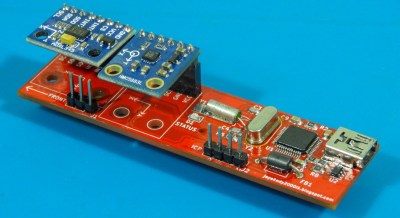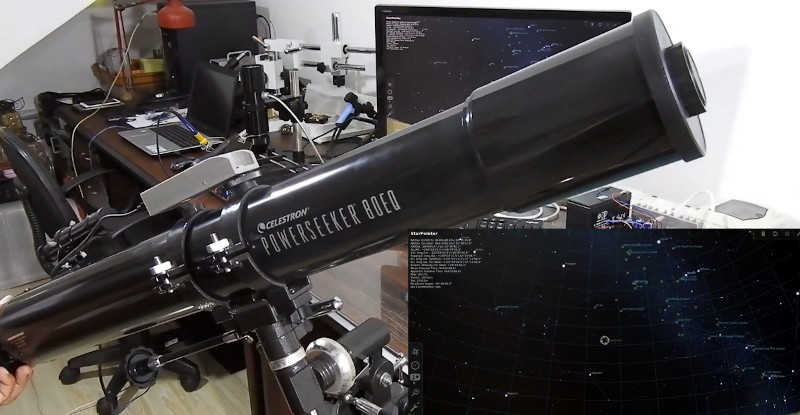On astronomical telescopes of even middling power, a small “finderscope” is often mounted in parallel to the main optics to assist in getting the larger instrument on target. The low magnification of the finderscope offers a far wider field of view than the primary telescope, which makes it much easier to find small objects in the sky. Even if your target is too small or faint to see in the finderscope, just being able to get your primary telescope pointed at the right celestial neighborhood is a huge help.
But [Dilshan Jayakody] still thought he could improve on things a bit. Instead of a small optical scope, his StarPointer is an electronic device that can determine the orientation of the telescope it’s mounted to. As the ADXL345 accelerometer and HMC5883L magnetometer inside the STM32F103C8 powered gadget detect motion, the angle data is sent to Stellarium — an open source planetarium program. Combined with a known latitude and longitude, this allows the software to show where the telescope is currently pointed in the night sky.
 As demonstrated in the video after the break, this provides real-time feedback which is easy to understand even for the absolute beginner: all you need to do is slew the scope around until the object you want to look at it under the crosshairs. While we wouldn’t recommend looking at a bright computer screen right before trying to pick out dim objects in your telescope’s eyepiece, we can certainly see the appeal of this “virtual” finderscope.
As demonstrated in the video after the break, this provides real-time feedback which is easy to understand even for the absolute beginner: all you need to do is slew the scope around until the object you want to look at it under the crosshairs. While we wouldn’t recommend looking at a bright computer screen right before trying to pick out dim objects in your telescope’s eyepiece, we can certainly see the appeal of this “virtual” finderscope.
Then again…who said this technique had to be limited to optical observations? As the StarPointer is an open hardware project, you could always integrate the tech into that DIY radio telescope you’ve always dreamed of building in the backyard.

















I made a device that uses Google Sky Map and a green laser pointer to locate objects and point to them:
https://www.instructables.com/Space-Laser-Manual-Go-To-for-Your-Telescope/
I’d like to use a green laser, but there’s so much air traffic around here, I worry about getting a SWAT team landing on me for pointing one skywards. (Yeah, I know to avoid pointing one towards an airplane, but after that drone panic, I worry that if they see a laser a mile off they’ll report they are under attack.)
All you have to do is to call your local policy department and tell them you’re using a laser with your telescope and if anyone calls about lasers being pointed at the sky it is you.
Bonus: you’ll probably get visited by the cops anyway, because they’re going to want to take a look through your scope too.
Now integrate with some AR.
How about an AR-15?
B^)
Well that’s a low calibre comment, what’s wrong with a .50 BMG ?
You know, the skies are super clear out here in the MOAB desert.
Is that a Tsar Bomba cloud?
I’ll have to check back later in case I missed it, but it interested to know accuracy of this.
I have an equatorial mount and 300mm lens I used last year for some astrophotography and these would probably be a major help to my endeavors
Absolutely no chance of it meeting the requirements of long exposure astro photography.
Equatorial mount… as long as that is set up correctly and the gizmo points you to the right patch of sky a simple sidereal drive should do the rest.
Should be great for aiming at say mag 9 nebulae that are unpossible to find in even a great finder except in super dark skies after dark adapting an hour, but that just pop out with a couple of dozen minutes of exposure.
“While we wouldn’t recommend looking at a bright computer screen right before trying to pick out dim objects in your telescope’s eyepiece”
Actualy Stellarium has a “night mode” with a red screen. It does not destroy your night vision.
There is a trick to ‘super’ night vision.
Never look above the horizon.
The sky is always brighter then dark land, if you can keep your eyes down for a couple of hours you will experience night vision better than you believe possible.
Not much use in Astronomy.
Both in the title image and video title screen, the magnetometer appears to be grossly skewed… Neither breakout would be consistent…. Cantilever mounted in mating pin headers, while the solder mask and silk screen decorated mounting holes sit empty of a standoff….
I’ve used Stellarium since it’s inception, it’s always been pretty amazing to me that such a polished piece of software is free. Integrating a telescope with Stellarium? This is a really cool project!
You could just strap a phone to the ‘scope. There’s probably a hack or driver than can remap the gyro/mag orientation so you can orient the phone for screen-reading convenience.
even better, ussing the phone for plate solving, no need to use sensors with noise and errors.
What are the best apps with plate solving I can use with my Android phone to find objects in the sky? I’d love to mount my phone to my telescope.
I made a similar device earlier, it was installed inside an case of old Golf Laser Rangefinder. I replaced original customized LCD to conventional 64×64 (I had to replace the polarizer to make it transparent).
BNO080 MEMS sensor was used for navigation.
Data from that device can be sent by Bluetooth to the PC (Stellarium) or to the phone (SkySafari).
The biggest problem that I found – MEMS Hall-magnetometer is too inaccurate for the starpointing task.
Maybe RM3100 Magneto-Inductive sensor would be more precise.